Laboratory - Astrologer`s tool for research. Galaxy.Laboratory astrological program
 Laboratory (Galaxy.Laboratory) is an astrological application program of Astrology researcher. It is designed to perform various types of analysis of thematic sets (charts of the same type and (or) events) and identify patterns of dependencies of celestial environment influence on the charts in question. This astrological program is included in Galaxy - Astrological Tools astrological software package
Laboratory (Galaxy.Laboratory) is an astrological application program of Astrology researcher. It is designed to perform various types of analysis of thematic sets (charts of the same type and (or) events) and identify patterns of dependencies of celestial environment influence on the charts in question. This astrological program is included in Galaxy - Astrological Tools astrological software packageLaboratory allows you to find the correlation between the position of the celestial objects and the sequence of similar events. The revealed consistent patterns allow to draw conclusions about probable impact of these objects on the chart characteristics (and events). This allows, for example, to use the obtained conclusions in the analysis of charts for career guidance.
Additional information about program
- Functionality of program
- Screenshots and brief description
- System requirements to program
- Load (download) resources
- Frequently asked Questions
- Project participants depending on personal contribution
- Program cost
- Prices
Functionality of program
| Types of analysis |
|
| Types of astrological analysis tools |
|
| Types of chart objects |
|
| Types of filters used in the analysis |
|
| The number of simultaneously used filters | not less than 5. A maximum number depends on the size of the screen, its height and the individual perception of the size of the final schedules |
Screenshots and brief description
To view large pictures, please, mouse click on picture.
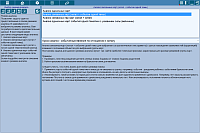
| A page to select the operating mode. It allows to select one of 4 available modes for analysis of charts:
|
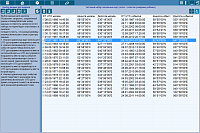
| Selection of charts (events) for analysis. It allows to download the data set saved earlier in DataFinder, and mark the records of this set, which will participate in the analysis |

| Displaying data string in the form of the related natal chart and event for a given astrological instrument. Choosing in selector a natal chart and astrological instrument you can instantly look at the chart, which will participate in the analysis |
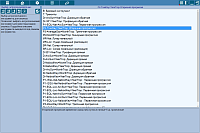
| Selection of astrological tool. It allows to select an astrological tool for some types of analysis. Description of the selected tool is displayed below the list of tools |
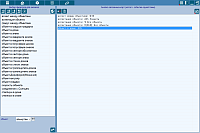
| Generation of analysis filterbank. There astrologer-researcher sets atomic filters to check the correlation of events with the entered criteria. Depending on the selected filter the program opens one or more elements to enter data for the specified filter. When setting the filter, it should be considered a feature of datasets, and use appropriate filters. For example, it makes no sense to check the position of objects in the houses on the thematic set presented by cosmograms |
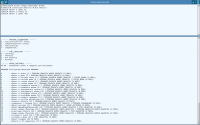
| Data Analysis Filter Editor. Laboratory has a data analysis filter editor for advanced users. This editor allows you to edit and expand (add new) filters from the list of existing ones, which significantly speeds up the work on the creation (formation) of a set of filters for frequency analysis of charts in order to identify common patterns. To make it easier to understand the construction of filters, the editor has a help window with a description of the filters and their components. |

| View of analysis conditions. It allows to view all the specified conditions for analysis to avoid gross errors in the use of the original data |
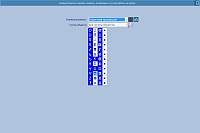
| On/off chart objects. It allows you to quickly turn on/off and switch the entire group of objects. The chart objects are not only displayed, but also participate in cross and full aspects (not typical for routine work) |
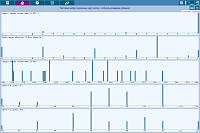
| The analysis result of related sets of charts (natal chart + event: birth of a child) with 5 configured filters. Depending on the applied filter the scale may have different ranges of data. For example, 'Aspect between the Sun and 5th house ruler' filter has a scale in the form of angular aspects and allows to display frequency of occurrence in a given set of data between these aspects of chart objects |
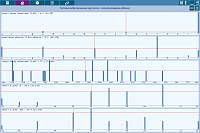
| The analysis result of related sets of charts allows to display frequency of occurrence of specified conditions and compare their values in the values cursor display mode. For example, the fifth filter shows that position of the 5th ruler in the 5th house occurs 4 times of 23 possible times in this data set, which corresponds to 17% of all positions in houses steward |
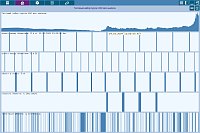
| The analysis result of single event charts of one theme with indication of the value showss the analysis results of USD rates for the specified time period with the specified filters. This mode shows specified filter responses (vertical lines) and repeat rate as repeating vertical lines. Thus it is seen how filters are relevant to the USD exchange rate. |

| The analysis result of single event charts of one theme with value indication allows to display the filter responses at specified time in the values cursor display mode. For example, 'Conjunct of Sun with Jupiter' filter correlates the stages of the USD exchange rate rise in many cases. This fact requires further verification. |

| The saved filter result of degrees between the Sun and 5th house ruler. The program allows to save results of the filter operation as well as individual elements, which is useful for preparation of reports and presentations |
Load (download) resources for Astrological program
- Promo clip Laboratory - Astrologer's research tool
- Video-instruction for work with Laboratory
- Video-instruction for work with Laboratory. Part 2 - new features
- Galaxy programs - new features. Update (20241217).
- Video-lessons on work with program elements
- Getting Started with Galaxy
- Learn Galaxy. Video lessons
- How I do it. Practical astrology lessons with Galaxy
- Videos on Galaxy astrology programs on the Internet
- Help file for Laboratory
- Databases and thematic sets
- Other Resources of site

